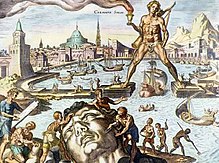Colossus of Rhodes
One of the Seven Wonders of the Ancient World, it was constructed to celebrate the successful defence of Rhodes city against an attack by Demetrius I of Macedon, who had besieged it for a year with a large army and navy.
[7] In 653, an Arab force under Muslim general Mu'awiya I conquered Rhodes, and according to the Chronicle of Theophanes the Confessor,[8] the statue was completely destroyed and the remains sold.
[10][11] In the late fourth century BC, Rhodes, allied with Ptolemy I of Egypt, prevented a mass invasion staged by their common enemy, Antigonus I Monophthalmus.
To celebrate their victory, the Rhodians sold the equipment left behind for 300 talents[12] and decided to use the money to build a colossal statue of their patron god, Helios.
Ancient accounts, which differ to some degree, describe the structure as being built with iron tie bars to which bronze plates were fixed to form the skin.
"[15] Modern engineers have put forward a hypothesis for the statue's construction, based on the technology of the time), and the accounts of Philo and Pliny, who saw and described the ruins.
Eight forged iron bars set in a radiating horizontal position formed the ankles and turned up to follow the lines of the legs while becoming progressively smaller.
[citation needed] Archaeologist Ursula Vedder has proposed that the sculpture was cast in large sections following traditional Greek methods and that Philo's account is "not compatible with the situation proved by archaeology in ancient Greece.
[17] Αὐτῷ σοὶ πρὸς Ὄλυμπον ἐμακύναντο κολοσσὸν τόνδε Ῥόδου ναέται Δωρίδος, Ἀέλιε, χάλκεον ἁνίκα κῦμα κατευνάσαντες Ἐνυοῦς ἔστεψαν πάτραν δυσμενέων ἐνάροις.
To you, O Sun, the people of Dorian Rhodes set up this bronze statue reaching to Olympus, when they had pacified the waves of war and crowned their city with the spoils taken from the enemy.
For to the descendants of Herakles belongs dominion over sea and land.The statue stood for 54 years until a 226 BC earthquake caused significant damage to large portions of Rhodes, including the harbour and commercial buildings, which were destroyed.
Ptolemy III offered to pay for the reconstruction of the statue, but the Oracle of Delphi made the Rhodians fear that they had offended Helios, and they declined to rebuild it.
The best of these are, first, the Colossus of Helius, of which the author of the iambic verse says, "seven times ten cubits in height, the work of Chares the Lindian"; but it now lies on the ground, having been thrown down by an earthquake and broken at the knees.
The Naturalis Historia is one of the largest single works to have survived from the Roman Empire to the modern day and purports to cover the entire field of ancient knowledge.
Pliny remarked: But that which is by far the most worthy of our admiration, is the colossal statue of the Sun, which stood formerly at Rhodes, and was the work of Chares the Lindian, a pupil of the above-named Lysippus; no less than seventy cubits in height.
In 653, an Arab force under Muslim general Mu'awiya I raided Rhodes, and according to the Chronicle of Theophanes the Confessor,[8] the remains of the statue constituted part of the booty, being melted down and sold to a Jewish merchant of Edessa who loaded the bronze onto 900 camels.
[9] The same story is recorded by Bar Hebraeus, writing in Syriac in the 13th century in Edessa[24] (after the Arab pillage of Rhodes): "And a great number of men hauled on strong ropes which were tied around the brass Colossus which was in the city and pulled it down.
"The New Colossus" (1883), a sonnet by Emma Lazarus written on a cast bronze plaque and mounted inside the pedestal of the Statue of Liberty in 1903, contrasts the latter with: The brazen giant of Greek fame with conquering limbs astride from land to land While these fanciful images feed the misconception, the mechanics of the situation reveal that the Colossus could not have straddled the harbour as described in Lemprière's Classical Dictionary.
[25] While scholars generally agree that anecdotal depictions of the Colossus straddling the harbour's entry point have no historic or scientific basis,[25] the monument's actual location remains a matter of debate.
[28] In December 2015, a group of European architects announced plans to build a modern Colossus bestriding two piers at the harbour entrance, despite a preponderance of evidence and scholarly opinion that the original monument could not have stood there.







